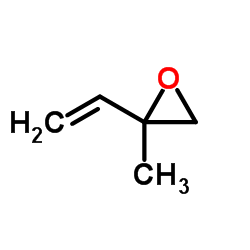Conjugation of isoprene monoepoxides with glutathione, catalyzed by alpha, mu, pi and theta-class glutathione S-transferases of rat and man.
J J Bogaards, J C Venekamp, F G Salmon, P J van Bladeren
Index: Chem. Biol. Interact. 117(1) , 1-14, (1999)
Full Text: HTML
Abstract
In the present study, the enzymatic conjugation of the isoprene monoepoxides 3,4 epoxy-3-methyl-1-butene (EPOX-I) and 3,4-epoxy-2-methyl-1-butene (EPOX-II) with glutathione was investigated, using purified glutathione S-transferases (GSTs) of the alpha, mu, pi and theta-class of rat and man. HPLC analysis of incubations of EPOX-I and EPOX-II with [35S]glutathione (GSH) showed the formation of two radioactive fractions for each isoprene monoepoxide. The structures of the EPOX-I and EPOX-II GSH conjugates were elucidated with 1H-NMR analysis. As expected, two sites of conjugation were found for both isoprene epoxides. EPOX-II was conjugated more efficiently than EPOX-I. In addition, the mu and theta class glutathione S-transferases were much more efficient than the alpha and pi class glutathione S-transferases, both for rat and man. Because the mu- and theta-class glutathione S-transferases are expressed in about 50 and 40-90% of the human population, respectively, this may have significant consequences for the detoxification of isoprene monoepoxides in individuals who lack these enzymes. Rat glutathione S-transferases were more efficient than human glu tathione S-transferases: rat GST T1-1 showed about 2.1-6.5-fold higher activities than human GST T1-1 for the conjugation of both EPOX-I and EPOX-II, while rat GST M1-1 and GST M2-2 showed about 5.2-14-fold higher activities than human GST M1a-1a. Most of the glutathione S-transferases showed first order kinetics at the concentration range used (50-2000 microM). In addition to differences in activities between GST-classes, differences between sites of conjugation were found. EPOX-I was almost exclusively conjugated with glutathione at the C4-position by all glutathione S-transferases, with exception of rat GST M1-1, which also showed significant conjugation at the C3-position. This selectivity was not observed for the conjugation of EPOX-II. Incubations with EPOX-I and EPOX-II and hepatic S9 fractions of mouse, rat and man, showed similar rates of GSH conjugation for mouse and rat. Compared to mouse and rat, human liver S9 showed a 25-50-fold lower rate of GSH conjugation.
Related Compounds
| Structure | Name/CAS No. | Molecular Formula | Articles |
|---|---|---|---|
 |
UNII:O364AQJ1K5
CAS:1838-94-4 |
C5H8O |
|
The biotransformation of isoprene and the two isoprene monoe...
1996-12-20 [Chem. Biol. Interact. 102(3) , 169-82, (1996)] |
|
Prediction of isoprene diepoxide levels in vivo in mouse, ra...
2001-12-21 [Chem. Biol. Interact. 138(3) , 247-65, (2001)] |
|
DNA-damaging ability of isoprene and isoprene mono-epoxide (...
2007-04-20 [Mutat. Res. 629(1) , 7-13, (2007)] |